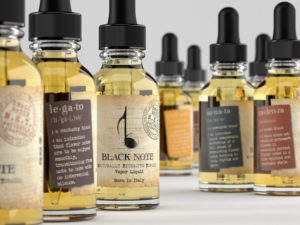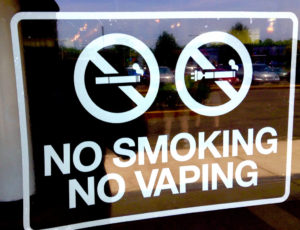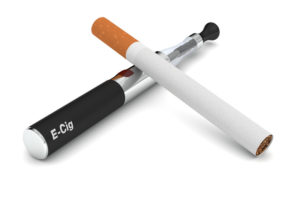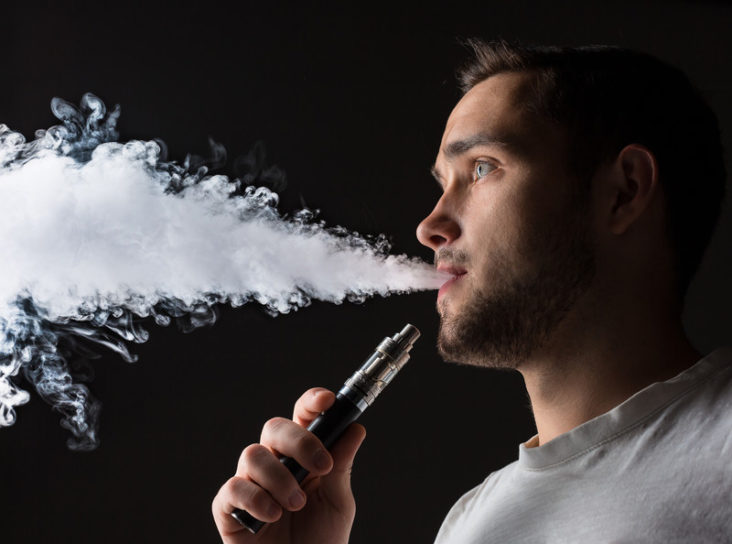You’ve probably heard of this…or seen the mushrooming of the stores in Toronto, if you drive along Danforth Ave or Kingston Road…full of store with this name on them: VAPE.
What is it?
Vaping can be defined as the act of inhaling and exhaling the water vapor produced by an electric device called vaporizer (also called a vape, or e-cigarette).

e-liquid
And if you’re wondering what is the “smoke” that comes out of the person’s mouth, well, it’s the e-liquid in gaseous form that is inhaled and exhaled by vapers. It usually looks thicker than smoke, but dissipates more quickly into the air and smells stronger, usually like fruit, candy, mint or the flavoring used.
Vaping is a tobacco-free, and in some cases even nicotine-free, version of a traditional tobacco cigarette, but we don’t use the word smoking as there is no smoke per see, there is only flavored water vapors that you inhale and exhale.
These stores sell these vaporizers and the flavorings that the customers use.
The history of Vaping
In contrary to the popular belief that vaporizers were “invented” a few years ago, their history dates back thousands of years. The earliest mention of vaping can be seen in the book called The History of Herodotus by the Greek Historian Herodotus. He talks about the first use of vaping while writing about the customs and traditions of Scythians, a massive clan of Iranian Eurasian rovers who used to live in the lands of what is now Southern Russia, back in 500BC. Scythians would throw weed on red-hot stones, which would turn into vapor immediately, and they would bathe in it and inhale it. Probably not the most sophisticated vaporizer, but that surely was an interesting ritual.
Irfan Sheikh – the physician of the Mughal emperor Akbar I (1542 – 1605 AD) – is accredited with inventing hookah, many consider it a key step towards the making of the modern vaporizer.
Skipping to more recent times, in the 1960s, a Korean War veteran Herbert A. Gilbert invented, and patented, the first e-cigarette as an alternative to burnt tobacco. His smokeless, non-tobacco cigarette resembled a modern e-cigarette: it included flavor cartridges, heating elements, and smokeless flavored air. Unfortunately it was never commercially realized. Manufacturers were enjoying the height of the tobacco cigarette in the 1960s, when cigarette ads and public smoking ran rampant. There was no need for a less addictive, and healthier alternative to smoking.
In the 2000s, Hon Lik, a Chinese pharmacist and small-time medical researcher made the first modern e-cigarette. Motivated by his own smoking addiction, and his father’s death from smoking-induced lung cancer, Hon Lik spent numerous years building a smokeless cigarette that worked. In 2006, he released his first e-cigarette to the international public. It contained a battery, plastic cartridge, ultrasonic atomizer and a nicotine solution suspended in propylene glycol.
By 2006 e-cigarettes had made their way to Europe, and then to North America. They started off as quite expensive items, but over the years, as more companies manufactured them, the price came down and popularity went up.
Canadian Vaping laws
At this time in Canada, electronic cigarettes (aka e-cigarettes, e-cigs, vapes, vaporizers, etc.) are 100% legal to use as individuals. There are currently no regulations as to where you can use them, with a few exceptions. There are however several municipal vaping regulations that have been created by municipalities and provinces.
You must be 19 to purchase e-cigarettes and vaping supplies. — Enacted Jan 1, 2016. Similar to tobacco products, it is illegal to buy and sell e-cigarettes and vaping supplies to anyone under the age of 19. It is required by law for vape shops in Ontario to receive proper government approved Identification from the customer before selling them e-cigarettes or supplies. Also, it is now illegal to use e-cigarettes (vape) in non-smoking areas.

No vaping sign
Data from the 2015 Canadian Tobacco, Alcohol and Drugs Survey suggests that in 2015, 26 per cent of Canadians aged 15 to 19 reported having ever tried an e-cigarette, up from 20 per cent in 2013.
For all businesses in Ontario, the use of e-cigarettes indoors now falls within the scope of the Smoke Free Ontario regulations. This means that use of an e-cigarette is restricted in exactly the same way as tobacco cigarettes.
Is Vaping Really Safe?
Well, this is a question that usually follows the question what is vaping. So, instead of giving you my personal opinion, let me simply state some of the results of some of the researches carried out to find the answer:
- Vaping is at least 95% safer than smoking – Public Health England
- Vaporizers are many times less harmful than traditional tobacco cigarettes, and vaping can even help smokers quit – American Heart Association
- The proven advantages of vaping outweigh its “potential” harms. Vaporizers are the first genuinely new way of helping people quit smoking that we have seen in many years – Royal College of Physicians – England
- Exhaled vapor has lesser volatile organic compounds than the normal exhaled breath, let alone exhaled smoke – Spanish Council of Scientific Research
So, is vaping safe? Well, despite all these researches and studies, we can’t say that vaporizers pose absolutely no threat to your health. But what is 100% safe? So let’s put the answer this way: vaping is safer than smoking, and can be a great aid in harm-reduction for people who want to quit smoking.

e-cig vs cigarette
And because e-cigarettes have been on the market for only about 10 years, there have been no long-term studies of people who have used them for 30 to 40 years. Therefore, the full extent of vaping effects on heart and lung health, as well as its cancer-causing potential over time is not known.
Another unanswered question is how the flavorings used in the devices may affect people’s health. Nearly 500 brands and 7,700 flavors of e-cigarettes are currently on sale in USA and Canada. It’s not yet known whether these flavorings have any respiratory effects when they are vaporized and inhaled. More research is needed to identify any hazards associated with the potential inhalation of flavoring agents.
